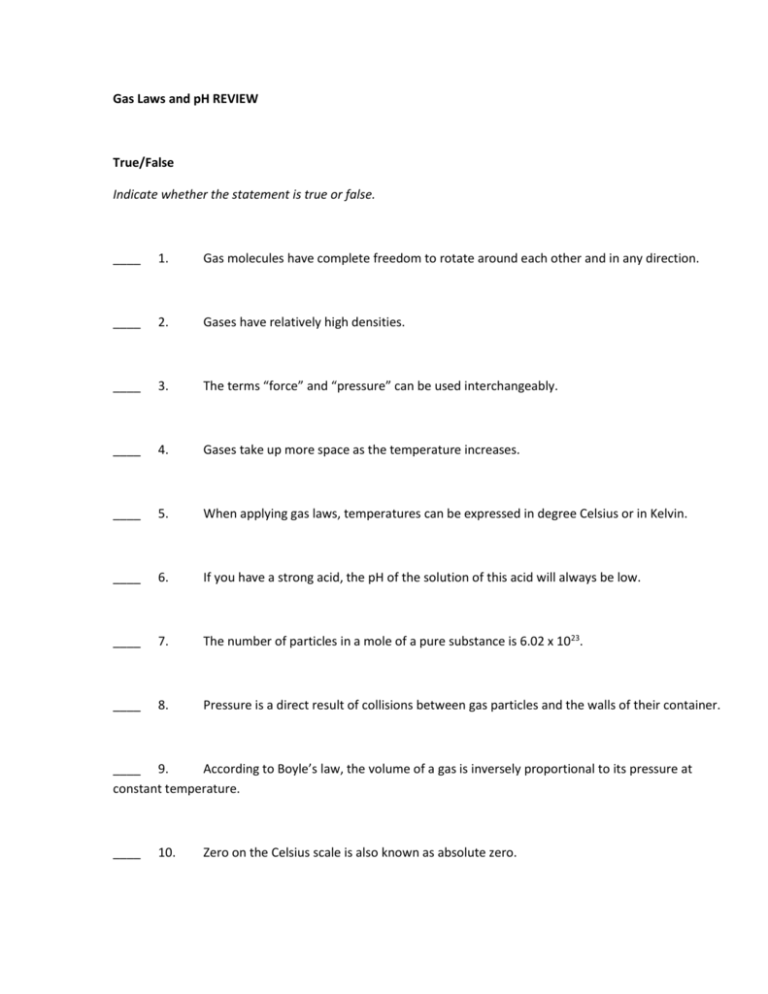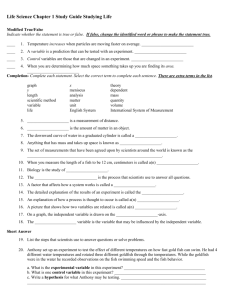Gas Laws and pH REVIEW True/False Indicate whether the
advertisement

Gas Laws and pH REVIEW True/False Indicate whether the statement is true or false. ____ 1. Gas molecules have complete freedom to rotate around each other and in any direction. ____ 2. Gases have relatively high densities. ____ 3. The terms “force” and “pressure” can be used interchangeably. ____ 4. Gases take up more space as the temperature increases. ____ 5. When applying gas laws, temperatures can be expressed in degree Celsius or in Kelvin. ____ 6. If you have a strong acid, the pH of the solution of this acid will always be low. ____ 7. The number of particles in a mole of a pure substance is 6.02 x 1023. ____ 8. Pressure is a direct result of collisions between gas particles and the walls of their container. ____ 9. According to Boyle’s law, the volume of a gas is inversely proportional to its pressure at constant temperature. ____ 10. Zero on the Celsius scale is also known as absolute zero. ____ 11. According to Charles’s law, the volume of a gas is inversely proportional to its pressure at constant temperature. ____ 12. An aqueous solution of acids causes red litmus paper to turn blue. ____ 13. An acidic solution contains more hydroxide ions than hydrogen ions. ____ 14. Acids add flavor to many beverages and foods. ____ 15. The relative amounts of hydrogen and hydroxide ions determine whether an aqueous solution is acidic, basic or neutral. Multiple Choice Identify the choice that best completes the statement or answers the question. ____ 16. A higher temperature leads to: a. lower kinetic energy b. higher kinetic energy c. slower molecules d. none of the above ____ 17. Molecules of two different gases that are at the same temperature will have: a. the same ratios of temperature and pressure b. the same ratios of temperature and moles c. the same ratios of temperature and volume d. all of the above ____ 18. There are differences between an ideal gas and a real gas. In a real gas: a. molecules are closer to each other b. molecules are further from each other c. intermolecular distances are not affected d. none of the above Identify the following substance as a strong acid or a strong base: ____ 19. HI a. strong acid b. strong base ____ 20. HClO4 a. strong acid b. strong base ____ 21. a. strong acid b. strong base Ca(OH)2 ____ 22. LiOH a. strong acid b. strong base ____ 23. A milkshake is sipped through a straw at the noted pressure. The straw contains 5.0 mL of liquid. How much liquid is consumed at 0.092 atm? a. 0.10 mL c. 6.3 mL b. 3.9 mL d. 7.8 mL ____ 24. in the figure? The volume of a sample of helium is 4.5 mL at 20.0°C and 203.0 kPa. What will its volume be a. 2.25 mL c. 4.34 mL b. 3.78 mL d. 6.85 mL ____ 25. At an ocean depth of 10.0 m, a diver’s lung capacity is 2.40 L. The air temperature is 32.0°C and the pressure is 101.30 kPa. What is the volume of the diver’s lungs at the same depth, at a temperature of 21.0°C and a pressure of 141.20 kPa? a. 1.12 L c. 1.78 L b. 1.66 l d. 4.86 L ____ 26. Gas is confined in a atm. After heating the tank, the pressure of the gas increases to 10.406 atm. What is the temperature of the heated gas? a. - c. b. d. ____ 27. The _____ in a balanced equation specify volume ratios for gaseous reactants and products. a. constants c. masses b. coefficients d. variables ____ 28. A gas is confined in a steel tank with a volume of 6.982 L. At 20.20°C, the gas exerts a pressure of 8.532 atm. After heating the tank, the pressure of the gas increases to 10.406 atm. What is the temperature of the heated gas? a. –32.60°C c. 84.59°C b. 24.63°C d. 92.64°C ____ 29. A steel tank with a volume of 9.583 L contains N2 gas under a pressure of 4.972 atm at 31.8 °C. Calculate the number of moles of N2 in the tank. a. 0.002 mol c. 0.525 mol b. 0.018 mol d. 1.90 mol ____ 30. What volume of oxygen is needed to react with solid sulfur to form 6.20 L of sulfur dioxide? a. 6.20 L c. 12.4 L b. 7.20 L d. 99.2 L ____ 31. When acids react with metals, they produce _____ gas. a. hydrogen c. sulfur b. nitrogen d. oxygen ____ 32. What is the pH of blood, given the hydrogen ion concentration is 4.0 x 10-8 M? a. 7.0 c. 7.4 b. 7.2 d. 7.6 ____ 33. Which model states that an acid is a substance that contains hydrogen and ionizes to produce hydrogen ions? a. Arrhenius c. Lewis b. Bronsted-Lowry d. Hydrogen ____ 34. a. 0.0045 What is the ph of 0.45 M of H2SO4? c. 0.45 b. 0.045 ____ 35. d. 4.50 A solution that contains equal concentrations of hydrogen and hydroxide ions is _____. a. an acid c. neutral b. a base d. ionized –5 ____ 36. At 298 K, the H of the solution? a. –4.04 c. 3.99 b. 5.00 d. 3.82 M. What is the pH Gas Laws and pH REVIEW Answer Section TRUE/FALSE NAT: NAT: 1. ANS: T PTS: 1 DIF: Easy REF: Section 14.1 2. ANS: F PTS: 1 DIF: Easy REF: Section 14.1 3. ANS: F PTS: 1 DIF: Easy REF: Section 14.1 4. ANS: T PTS: 1 DIF: Easy REF: Section 14.2 5. ANS: F PTS: 1 DIF: Easy REF: Section 14.2 6. ANS: F PTS: 1 DIF: Easy REF: Section 13.2 7. ANS: T PTS: 1 DIF: Bloom's Level 1 B.1 | B.2 STA: ABC 16.1 8. ANS: T PTS: DIF: Bloom's Level 2 B.4 STA: ABC 16.3 9. ANS: T Definition of Boyle’s law. 1 PTS: 1 STA: ABC 16.6 10. DIF: ANS: Bloom's Level 1 NAT: B.4 F Zero on the Kelvin scale is also known as absolute zero. PTS: 1 STA: ABC 16.5 11. DIF: ANS: Bloom's Level 1 NAT: UCP.2 | UCP.3 F According to Charles’s law, the volume of a gas is directly proportional to its Kelvin temperature at constant pressure. PTS: 1 DIF: 1 REF: Page 423 OBJ: 14.1.1 State Boyle's law, Charles's law, and Gay-Lussac's law. NAT: UCP.1 | UCP.3 | B.4 TOP: State Boyle's law, Charles's law, and Gay-Lussac's law. MSC: 1 STA: ABC 16.5 KEY: Charles's law NOT: According to Boyle's law, the volume of a gas is inversely proportional to its pressure at constant temperature. 12. ANS: F An aqueous solution of acids causes blue litmus paper to turn red. PTS: 1 DIF: Bloom's Level 1 NAT: UCP.2 | A.1 | B.3 STA: ABC 23.2 13. ANS: F A basic solution contains more hydroxide ions than hydrogen ions. PTS: 1 STA: ABC 23.2 14. NAT: NAT: DIF: ANS: Bloom's Level 1 T PTS: NAT: UCP.2 | B.3 1 DIF: Bloom's Level 1 1 DIF: Bloom's Level 1 UCP.2 STA: ABC 23.2 15. T PTS: STA: ABC 23.2 ANS: UCP.2 | B.2 MULTIPLE CHOICE 16. ANS: B PTS: 1 DIF: Easy REF: Section 14.2 17. ANS: D PTS: 2 DIF: Average REF: Section 14.2 18. ANS: A PTS: 2 DIF: Average REF: Section 14.2 19. ANS: A PTS: 1 DIF: Easy REF: Section 13.1 20. ANS: A PTS: 1 DIF: Easy REF: Section 13.1 21. ANS: B PTS: 1 DIF: Easy REF: Section 13.1 22. ANS: B PTS: 1 DIF: Easy REF: Section 13.1 23. ANS: B DIF: Bloom's Level 3 NAT: UCP.2 | UCP.3 | B.4 NAT: UCP.2 | UCP.3 | B.6 NAT: UCP.3 | B.4 | B.6 P1V1 = P2V2 PTS: 1 STA: ABC 16.6 24. ANS: C Use Charles’s law PTS: 1 STA: ABC 16.6 25. DIF: ANS: Bloom's Level 3 B Use the combined gas law. PTS: 1 STA: ABC 16.6 26. P1 / T1 = P 2 / T 2 DIF: ANS: Bloom's Level 3 C Convert Celsius to Kelvin PTS: 1 STA: ABC 16.6 27. DIF: ANS: Bloom's Level 3 NAT: UCP.2 | UCP.3 | B.4 | B.6 NAT: UCP.2 | B.3 B See section 13.3, gas stoichiometry. PTS: 1 STA: ABC 16.6 28. DIF: ANS: Bloom's Level 1 C Using Gay-Lussac’s law, . Feedback A First, multiply the pressure and temperature of the gas. Then, divide the product with the pressure before heating the tank, not after heating it. B First, convert the temperature in Celsius to Kelvin. Then, calculate the temperature. C Correct! D The product of pressure and temperature of the gas is incorrect. PTS: 1 DIF: 2 REF: Page 426 OBJ: gas. 14.1.2 Apply the three gas laws to problems involving the pressure, temperature, and volume of a NAT: UCP.1 | UCP.3 | B.4 TOP: Apply the three gas laws to problems involving the pressure, temperature, and volume of a gas. KEY: Gay-Lussac's law 29. ANS: STA: MSC: ABC 16.6 3 D According to the ideal gas law, PV nRT. Feedback A Use the correct numerical value of R. The value of R is not 62.4. B Use the correct numerical value of R. The value of R is not 8.314. C Divide PV by RT to obtain the number of moles of N2. D Correct! PTS: 1 DIF: 2 REF: Page 436 OBJ: 14.3.1 Relate the amount of gas present to its pressure, temperature, and volume by using the ideal gas law.NAT: UCP.1 | UCP.3 | B.4 STA: ABC 16.3 TOP: law. Relate the amount of gas present to its pressure, temperature, and volume by using the ideal gas KEY: Applying the ideal gas law 30. ANS: MSC: A The chemical reaction of sulfur and oxygen is: S(s) + O2 2(g) The ratio of these gases is represented as 1:1:1. 3 Use the balanced equation to find the volume ratio of O2(g): Feedback A Correct! B Instead of adding the volume of sulfur dioxide to the volume of oxygen, multiply the two volumes. C Balance the equation correctly. D Instead of multiplying the volume of sulfur dioxide by the molecular weight of oxygen, multiply the two volumes. PTS: 1 DIF: 3 REF: Page 440 OBJ: 14.4.1 Determine volume ratios for gaseous reactants and products by using coefficients from a chemical equation. NAT: UCP.3 | B.3 STA: ABC 16.1 TOP: Determine volume ratios for gaseous reactants and products by using coefficients from a chemical equation. KEY: Calculations involving only volume MSC: 3 31. NAT: A PTS: UCP.2 | B.3 | B.6 32. NAT: ANS: ANS: UCP.3 | B.2 1 DIF: STA: ABC 23.2 1 DIF: C PTS: STA: ABC 23.2 Bloom's Level 1 Bloom's Level 3 33. NAT: NAT: NAT: ANS: A PTS: UCP.2 STA: ABC 23.2 34. B ANS: PTS: 1 DIF: Bloom's Level 2 1 DIF: Bloom's Level 3 DIF: Bloom's Level 1 UCP.3 STA: ABC 23.3 | ABC 24.2 35. C ANS: PTS: UCP.2 STA: ABC 23.2 36. B ANS: 1 pH –log [H ] Feedback A The pH of the solution is the negative logarithm of the hydrogen ion concentration. B Correct! C Calculate the pH by taking the negative logarithm of the hydrogen ion concentration. D Use the formula, pH = -log (hydrogen ion concentration), to calculate pH of the solution. PTS: 1 DIF: OBJ: 19.3.3 Calculate the pH and pOH of the aqueous solution. NAT: B.2 | B.3 STA: KEY: pH 3 MSC: 1 REF: Page 610 ABC 23.3 TOP: Calculate the pH and pOH of the aqueous solution.







